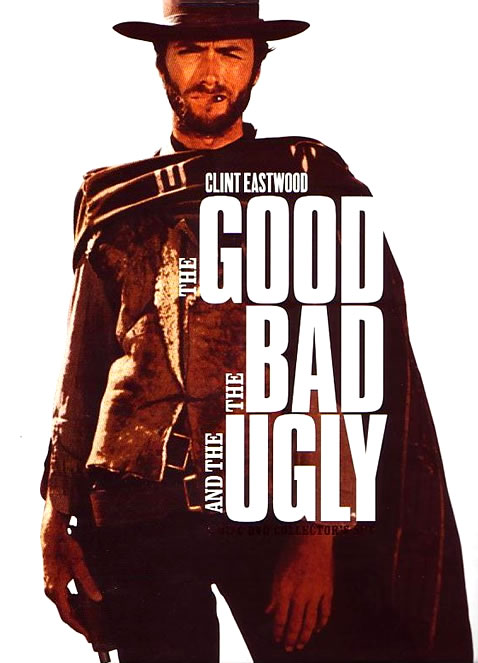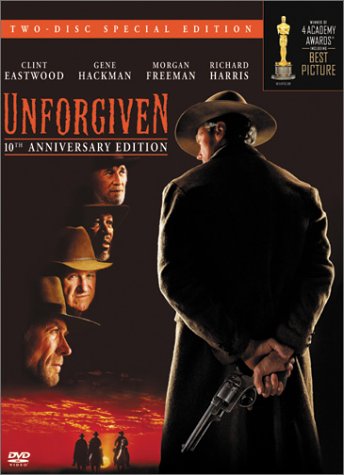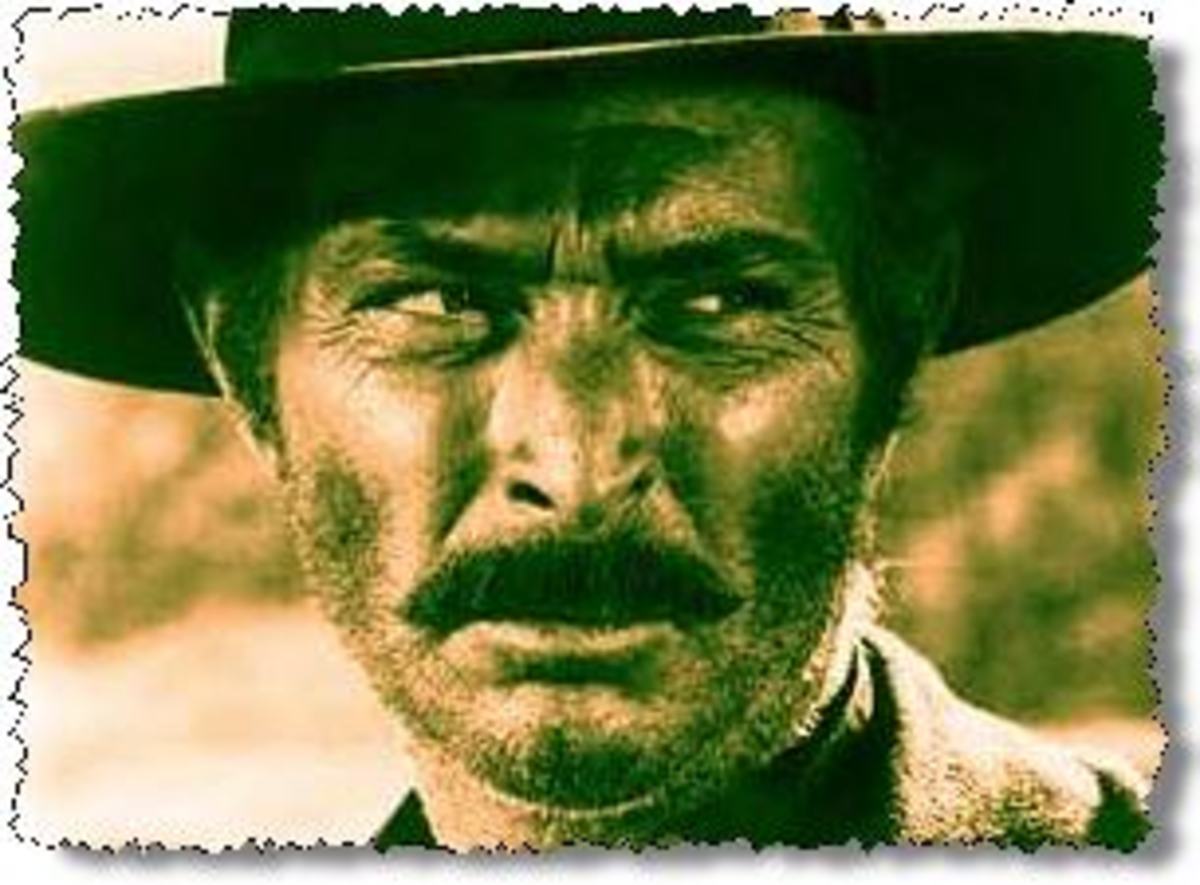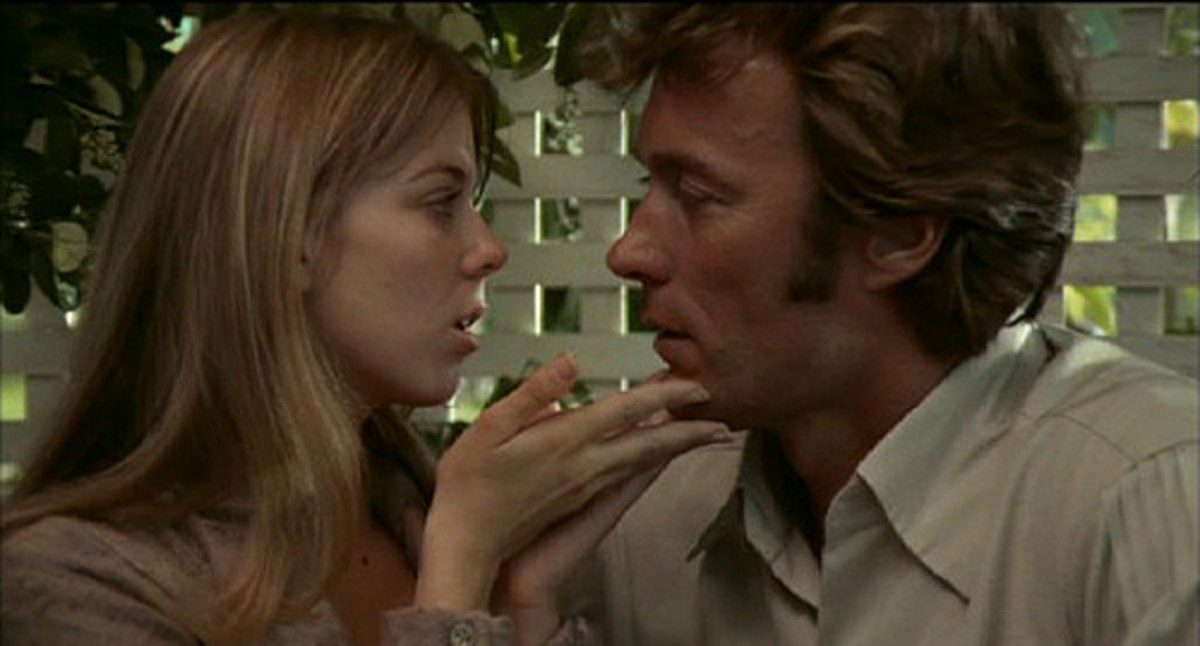Of Six Guns and Spaghetti


Of Sixgun’s and Spaghetti
Hollywood’s misinterpretation of the romantic old west was revolutionized by the more brutal and realistic spaghetti western environment. Spaghetti western directors in Italy were able to recreate the old west free of Hollywood’s liberal interpretation of the western genre; and thus this genre cannot be classified under the typical Hollywood western genre. Along with the recreational value the spaghetti westerns provided directors, it also allowed the directors the create movies cheaper. A John Wayne formulaic could be considered to be a typical Hollywood western. The typical hero is a white Angelo-Saxon, white hatted, white horsed, self-sacrificing man of the law. The typical Hollywood villain is a black hatted, black horsed, smooth talking lecherous man. The heroes of the spaghetti films tend act more like the black hatted villains of the typical Hollywood genre. The color scheme of good and evil being black and white was often used in typical Hollywood productions. The spaghetti western film peak era was between 1966 and 1967, where over 300 films were produced. Spaghetti western influenced films to portray to American society with a detached calmness through all the brutality.
Clint Eastwood as actor and director of the film Unforgiven blends both styles, to create the modern western genre. The atmosphere of the movie doesn’t quite have to brutality of spaghetti westerns but the environment is still realistically brutal. The film Unforgiven begins with the old retired outlaw, which goes against the typical Hollywood western genre ideal that evil is punished. Spaghetti westerns introduced the idea of the anti-hero to Hollywood’s western film. Eastwood’s character of the redeemed outlaw, William Munny, presents a strong vision of the anti-hero.
“BOOM”
“Well sir, you are a cowardly son of a bitch. You just shot an unarmed man”
“Well he should have armed himself if he was going to decorate his saloon with my friend [Morgan Freeman’s dead body].”
“You be William Munny out of Missouri? Killer of women and children?”
“That’s right [pause]. I killed women and children, killed everything that every walks or crawled at one time or another. And I’m here to kill you little Bill [Sheriff]. For what you did to Ned [Morgan Freeman]. You boys better move away [takes aim with shotgun] (Unforgiven 2).”
Although William Munny, could be described as the villain, although he filled the role of the hero in the movie Unforgiven. William Munny is the protagonists who give into his “inner demons, and becomes a truly brutal character. The atmosphere of the movie is a blend of the spaghetti westerns brutal realism and the typical Hollywood genre. The main characters of Unforgiven are all bounty hunter killer types typical of spaghetti westerns. In many spaghetti and modern westerns money is the primary motivation and the second motivation usually is revenge.
“I don’t deserve this...to die like this...I was building a house.”
“Deserve got’s nothing to do with it.”
“I’ll see you in hell William Munny [Eastwood takes aim and blows little Bills head off]” (Unforgiven 2).
The last quote by little Bill parodies typical western in the sense that the deserving didn’t usually die, and that William Munny’s evil character didn’t get his “just” punishment; providing Hollywood’s ideal that evil should be punished. Revenge for Morgan Freeman’s death was Eastwood’s motive for killing little Bill. Although, in the film The Good, the Bad, and the Ugly money is viewed as just a prize, the three protagonists portray the theme of the movie as being more like a treasure hunt rather than just a western. At the end of the treasure hunt Blondy, Tuco and Angel Eyes have mexican-standoff. As Blondy put is they must” earn their gold.” The heroes never seems to spend their money; whereas in typical Hollywood westerns along with modern westerns money is something to be invested. Money in the movie Unforgiven for William Munny character is something to be invested. Whereas Morgan Freeman’s character views money as more of just a price to be won.
In the movie The Good, the Bad and the Ugly several aspects of the spaghetti western genre deviation become conspicuous. The good and evil color scheme for the heroes and villains are done away with. Heroes and villains share common characteristic except for the fact that the hero doesn’t kill innocents. The heroes in spaghetti westerns are not law enforcers rather they are bounty hunters. The story, the characters, the environment is brutal and creates a mistrustful brutal atmosphere. In the beginning Blondy and Tuco are going form town to town collecting the reward money on Tuco head and then freeing him from the hang mans noose.
“There are two kinds of people in the world my friend, those with a rope around their neck and the people who have the job of doing the cutting. Listen, the neck at the end of the rope is mine. I run the risks. So the next time I want more than half.”
“You may run the risks, my friend, but I do the cutting. If we cut down my percentages ... Cigar?...It’s liable to interfere with my aim.”
“But if you miss, you had better miss very well. Whoever double crosses me and leaves me alive, he understands nothing of Tuco. Nothing” (The Good, the Bad and the Ugly 1).
Eastwood in the film Unforgiven embellishes on the brutal environment in this quote:
“It don’t seem real that guy, ain’t gonna breathe again ever. Now he’s dead...all on the account of pulling a trigger.”
It’s a hell of a thing killing a man. Take away all he’s got and take away all he’s ever gonna have.”
“Yeah..I guess they had it coming [drinks a big gulp of whiskey].”
“We all have it coming kid” (Unforgiven 2).
Spaghetti westerns tended to create parodies of typical Hollywood westerns, in fact hints of these parodies still exist in modern western. These westerns could almost be considered to make fun of the typical Hollywood western. In the film the Good, the Bad and the Ugly, an one-armed murderous assassin is sneaking up on Tuco while he is bathing. The bounty hunter surprises Tuco and starts explains his hatred toward Tuco. A clicking sound comes from Tuco’s bubble bath and three shots are fired at the bounty hunter, killing him. “When you have to shoot. Shoot. Don’t Talk,”(The Good, the Bad and the Ugly 1) says Tuco. This scene from The Good, the Bad, and the Ugly, presents the western villains major flaw. The villain in classical western movies would explain his master plain, or talk about their favorite pie recipes, all the while giving the hero time to win.
There are three protagonists in the film The Good, the Bad and the Ugly, Blondy (the Good), Angel Eyes (the Bad), and Tuco (the Ugly). Protagonists in typical western films tend to be concerned with right societies wrongs and crusading around the frontier helping those who cannot help themselves. However the protagonists along with antagonists in spaghetti western films are primarily concerned with exploiting societies wrongs. In the film the Good, the Bad and the Ugly, Angel Eyes is marauding as a Sargent in the Union army. The protagonists Angel Eyes, being the perfect example of a spaghetti western character, exploits the Confederate POWs, by robbing and murdering them.
“For the last time Sargent I’m telling you I want the prisoners treated as prisoners no more brutalities...while I am in charge here the prisoners are not to be tortured or cheated or murdered”
“Is that an accusation?”
“Sargent, gangrene is eating my leg away not my eyes”
“...But as long as I’m commandant, I won’t permit any such trickery! Am I clear?”
“Yes, Sir. Just as long as you’re commandant” (The Good, the Bad and the Ugly1).
The lines between hero and villain become blurred in the brutal environment in spaghetti and modern style westerns. The hero character of Blondy, played by Clint Eastwood, shares a few of the common characteristics such as race and sharpshooting skills that westerns heroes tend to display, however besides these obvious characteristics the hero of spaghetti westerns could almost be considered to be the villain of Hollywood’s model westerns. Blondy uses the law to his own personal gain which is a trait typical westerns would view as being an embodiment of evil. Blondy is a calm quite killing machine who shoots first and asks questions later. The two heroes of the film Unforgiven are Clint Eastwood and Morgan Freeman. They are both retired outlaw bounty hunters seeking forgiveness for their wicked youth. However Morgan Freeman, being black and a hero, violates the White Angelo-Saxon hero rule of typical Hollywood westerns. Spaghetti westerns influenced modern westerns to be realistic.
The villain character of westerns has evolved because of the spaghetti westerns influence. The character of Angel Eyes (the Bad) is the bad guy. He wears the villains trademark black hat and rides the trademark dark horse. He is a smooth talker and aspires to lecherous designs towards women. However this western villain follows a strange code of honor when money is concerned. At one point of time Angel Eyes is paid to kill a man but before doing his job he is paid buy the victim to kill his current employer. He returns to his employer to take care of the deed and justifies his actions with the words,
“Well you don’t have to worry he’ll never tell anybody ever again.”
“O yeah perfect here this is for you you're worth it worth five hundred dollars.”
“Almost forgot he gave me a thousand dollars, I think his idea was for me to kill you...[employer starts laughing]...but you know what the pity is when I am paid I always follow my job through”
“Nooo..Angel Eyes” [three gunshots and Angel Eyes starts laughing] (The Good, the Bad, and the Ugly 1).
Angel Eyes seems to be the model villain character of many Hollywood western films. The bad guy character in the movie Unforgiven is the vigilant sheriff of a small western town. He could be described as being a classical hero from many different classic Hollywood movies. He is clean, upright white Angelo Saxon who respects the law (of that time period). He uses bullets and words with equal care and he hates the British. At one point of the movie the Sheriff confronts a British gunslinger and asks the British gunslinger to relinquish his gun due to city ordinance.
“You would live me at the mercy of my enemies”
“Enemies Bob you been talking about the queen again...on Independents Day, Bob”(Unforgiven 2).
The Sheriff then promptly beats the British gunslinger within an inch of his life. The Sheriff shows no remorse in brutally beating up the British gunslinger. In fact, the Sheriff actually seems to get gratification from beating up a British gunslinger.
When spaghetti western first hit American cinema controversy of cultural roots arose. Some people argued that the desolate bright landscapes of Italy falsely portrayed the west. However spaghetti westerns purposely used Italy’s heat to better portray the actors. In classical westerns the characters especially the heroes were supposed to remain clean, and directors of the classical westerns went so far as to powder the actors to stop sweat. The spaghetti westerns often used a sweating face to better portray emotions like fear or angry. Such as in the movie The Good , the Bad and the Ugly:
“Your from baker [Angel Eyes smiles] tell baker that I told him all I know already. Tell him that I want to live in peace already [sweat pours off the poor farmer]. There is no use in him tormenting me. Now I know nothing at all about that case of coins. Now that gold has disappeared and if he would have listen we could have avoided this all together...what does he pay you for murdering me?” (The Good, the Bad, and the Ugly).
The desolate landscape that Italy provides have develop the characters in the film. The characters were direct results of their environment. Modernized westerns have cowboys beseeched with sweat pouring down their bodies which helped set the mood for the film.
Typical liberal Hollywood views presented black and Indians sympathetically is typical Hollywood views. There was always the peace loving Apache leader or the defeated Indian Union soldier in typical western films. Spaghetti westerns tended to view the different races and being equally guilty of crimes. Usually the “gringos” and the Mexican’s stayed in their own groups, and the hero of spaghetti westerns would play off both groups to better exploit them.
Unlike modern western spaghetti westerns tend to choose sides in historical events. In the film The Good, the Bad and the Ugly Tuco and Blondy often changed sides during the course of the movie. At one point of time they blow up a bridge that separate a Confederate and Union army.
“You’ll all turn to dust but one thing is sure, boys...Branson Bridge will stand unbroken. I’ve done it. I’ve blow it up in here [his mind]. I’ve destroyed it all...If I could do it I could save thousands of men” (The Good, the Bad and the Ugly 1).
The only reason they blew up the bridge was to get to their treasure which lay on the other side of the river. They treat both sides with a detach neutral view. However modern westerns portray the south as being inertly evil and modern westerns tend to show a little more compassion to the dying soldier in the war.
One of the major innovation used in spaghetti westerns is silence. In the film The Good, the Bad and the Ugly, uses silence to increase the tension of the film. At the end of the movie there is a four minutes fifteen seconds pause where each of the three protagonists earn their gold. They stare at each other, waiting for the other to reach for his gun. The music during this pause also build up and finally after four minutes fifteen seconds the tension is released. Leaving Angel Eye died and the treasure going to Tuco and Blondy. This build up of tension is used in many other modern westerns like in Unforgiven. Both William Munny and the Kid wait outside of an outhouse to kill a man and collect the bounty of his head. The tension builds up and leads to the Kid killing his bounty. It is obvious that it is the first time the Kid killed anybody. Silence can be the single greatest thing that directors can introduce into their movies.
In spaghetti and modern style westerns the family unit is stressed as more like a band of brothers. That is to say that the characters like Tuco and Blondy become like brothers. Whereas families fall on hard times in the desolate west and become separate. Outlaws had to consider each other family because it was all that they had. Tuco was no exception although he tried to pretend his brother was still family.
“My belly’s full. Nice guy my brother. I didn’t tell you my brother was in charge here. Everything, like the pope almost. He’s in charge in Rome. My brother, he says to me: Stay, brother, don’t go home. We never see each other. Whenever we see each other, he never lets me go...even a tramp like me...I know there’s a brother somewhere who will never refuse me a bowl of soup” (The Good, the Bad, and the Ugly 1).
Modern westerns are fulls of traces left over from spaghetti westerns. When Hollywood first thought up the idea of western films they focused primarily on historical folk-lore instead of the social economical history. Spaghetti westerns could be considered to be melodramatic. The characters in the films presents a kind of realism that melodramatic films tend to portray. These types of westerns were considered to be brutal yet realistic, which made them rather popular when this revolutionized westerns hit American cinema. Modern westerns have traces of a romantic west and at the same time traces of a brutal realistic environment. Spaghetti westerns paved the way for faster paced movies. For example, in the film Unforgiven William Munny after giving in to his “inner demons” kills five people in less than five seconds. In a way action films own something to the spaghetti western genre. Although spaghetti westerns didn’t follow the idea that all evil is punished, it usually had the anti-hero killing the villain of the movie. Like in the end of The Good, the Bad and the Ugly. The anti-hero is very popular in our culture today. In many films the hero is against the establishment and considered an all around bad-ass.







